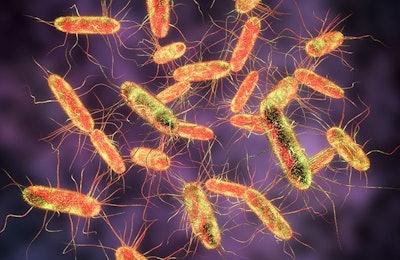
Controlling Salmonella in poultry is complicated and too often frustrating. Sampling programs don’t always give us strong correlations between its presence on the farm and at the processing plant. Confusing testing program results can make it difficult to devise control strategies and all the while demands for food safety increase.
Further complicating matters, some Salmonella species have developed avoidance strategies, making their control in chickens particularly difficult.
While we have studied the interaction between Salmonella and chickens for many years, only recently have we begun to research the “black box” of Salmonella and poultry gut microbiome interactions. New research reveals Salmonella has developed strategies to control gut microbes in surprising ways and to affect key changes in gut microbiome metabolism to complement these strategies. The research increases uncertainty around Salmonella control, but opens a new window of opportunity for understanding and possibly controlling, Salmonella.
Unexpected impact
The study makes it clear that Salmonella’s impact on the microbiome is strange.
We use the term dysbiosis when talking about a microbiome that has gone wrong, with an increase in the prevalence of a few problematic bacterial species and a decrease in the diversity of the microbiome. However, in this challenge study, while Salmonella acted as expected, colonizing the ceca without causing the chickens any systemic problems impact on the microbiome was unexpected.
The presence of Salmonella increased diversity of the microbiome, promoting colonization by several non-specific minority members of the microbiome. Salmonella has developed strategies resulting in tolerance by the avian host’s immune system; it also appears to additionally foster tolerance by the host’s microbiome. By increasing diversity and promoting growth of a variety of bacterial species, Salmonella may be creating a signal that “all is well” in the ceca, protecting it further still.
Not only is Salmonella having an interesting impact on the bacteria present in the microbiome, it is also creating unexpected impacts on the metabolic pathways in the microbiome.
Solving the great puzzle?
When the microbiome changes during times of stress, for example, due to dietary changes, the metabolic pathways change, adapting to the new normal. In this study, there were hardly any changes soon after the challenge. Between the second and third week of infection, Salmonella surprisingly changed multiple key metabolic pathways in the microbiome, such as protein synthesis and secretion, nucleotide production and the ability of microbial communities to “communicate” and adhere to the gut wall.
By the end of the third week post-infection, the gut microbiome looked very different from an increase in diversity and species present, but there were very few, and only minor, functional changes. Both metabolically and through the bacterial species present, Salmonella was able to manipulate the microbiome to create tolerance of its presence and to send out “all is well” signals to the host and the microbiome.
Salmonella is an expert at evading the immune system of birds and this new microbiome research shows that it is also an expert at manipulating the chicken gut microbiome.
While this research shows that controlling Salmonella maybe even more complicated than we thought, it also demonstrates that, if we are looking at Salmonella without looking at the gut microbiome, we only have a partial understanding of the problem. The more we look at the whole system - microbiome, host and pathogen - the more likely we are to develop solid and lasting solutions.

















